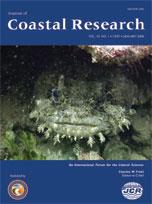The failure of coastal rock cliffs is attributed to a variety of factors such as weathering, wave action, ground water level, and rock and joint parameters. The wave-induced undercutting of the vertical cliff face is hereby assumed to play a critical role. Very little attention has, however, been paid to the gravity-induced stresses within the cliff face. A numerical analysis of the stress distribution in idealised rock cliffs of varying slopes (50–90°) and in various stages of undercutting has been conducted. Investigated parameters included slope angle, cliff height, influence of a cliff base cavity, front face loading, and cliff surcharge loading. The analysis showed that stresses in the cliff face geometry immediately after a failure were insignificant. With the steepening of the cliff, stresses increased to reach very high values for a vertical cliff face. Additional undercutting of the cliff resulted only in a slight increase of those stress magnitudes. The steepened rock cliff can result in an unstable equilibrium condition, depending on cliff geometry and the ratio of gravity-induced stresses (a function of cliff height) and material strength, which can lead to sudden cliff failure. The results of this study indicate that the most important parameter in cliff destabilization is wave-induced steepening of the cliff slope.
How to translate text using browser tools
1 January 2008
Effect of Cliff Shape on Internal Stresses and Rock Slope Stability
Guido Wolters,
Gerald Müller
ACCESS THE FULL ARTICLE

Journal of Coastal Research
Vol. 2008 • No. 241
January 2008
Vol. 2008 • No. 241
January 2008
cliff stability
cliff steepness
downfall
Rock erosion
tension crack
wave impact




